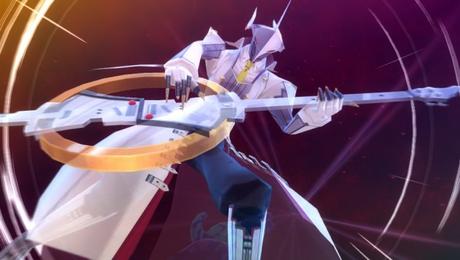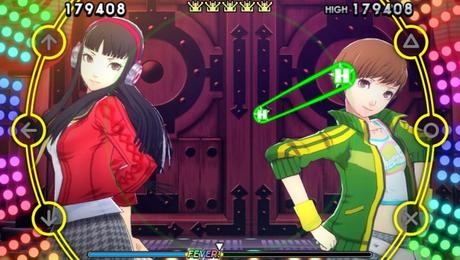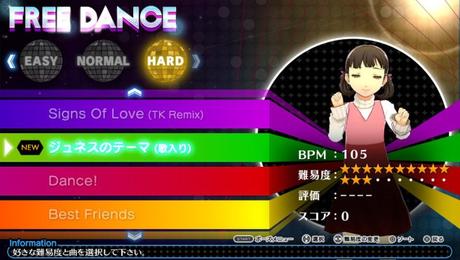 Title: Persona 4 Dancing All Night
Title: Persona 4 Dancing All Night
Genre: Dancing Rhythm Game
Publisher: Atlus
Developer: Atlus
System: PS Vita
Release Date: 06-25-2015 (JP)
A rhythm game featuring Persona 4 music and, more importantly, Yu Narukami’s swag dance moves.
Persona 4 has become Atlus’ favorite cash cow, leading to two anime series, multiple fighting games, an Etrian Odyssey-style crossover spinoff with its predecessor, and…a dancing rhythm game. They’re also apparently all supposed to be canon, which seems like a cheap sell to me. I can’t speak for the other games, but P4DAN‘s story suffered a lot from taking itself too seriously as it was supposed to be canon. It tries to talk about idols showing their true selves versus being the characters that their fans want them to be/what their producers “sell” them as, but doesn’t do anything that nothing else has done before, and concludes it with some very cheesy friendship speeches.
Sure, the depiction of the power of friendship was moving and what made Persona 4 a popular game, but when you have to hear the characters reaffirm their nakama status every five minutes, you get the idea. There isn’t even anything in this game that actually challenges the main cast’s friendship, unlike the original game. This game also introduces a good number of new characters in the form of Rise’s kouhai in the idol industry, none of them getting much development since the game’s story mode is less than 10 hours long.
The story is lacking, but this is a rhythm game first and foremost, so it’s out of the ordinary to have a story in the first place. As for the rhythm portion, it doesn’t really reach insanely hard levels, unlike some other rhythm games where many players will just reach an insurmountable wall in skill level required. Even the hardest songs in the base game feel very reasonable for a regular person. The difficulty is also more or less even throughout the entire song, which means you won’t encounter stages where the entire song is easy except for this one suddenly extremely difficult part that screws you over in a matter of seconds (e.g. Project Diva f 2nd).

You can’t freely choose the main dancer like you can in the Project Diva games, but each character dances in a different style, from Yu’s swag moves to Yukiko’s ballet-like spins and Nanako’s very cute dance befitting of a little girl. At the very end of a song, the main dancer’s persona (if they have one) comes out and plays an instrument to end of the sequence. There are also loads of unlockable costumes and accessories, not even including DLC. Kanji’s swimsuit combined with his dance moves make a very screencap-worthy game.
Scoring and determining whether you pass or fail the song is almost entirely separate, resulting in instances where you can get a better score but fail the song or get a worse score and pass. Much like other rhythm games, getting perfects and keeping up a huge combo will play a huge part in scoring. However, to actually clear the song, you must keep the “audience” in high spirits. They start off as neutral (white), and you must end the song on green or above to pass the song. If you miss notes, the audience’s enthusiasm will fall to yellow and red, and eventually cut your song short as you get kicked back to the menus. Here’s the thing: on higher difficulties, a single missed note will take a lot of correctly hit notes to recover from. If you manage to do very well in the first 3/4 of the song and then mess up badly at the very end, you will probably fail the song even if you managed to score higher than that time when you passed.
P4DAN may be very welcoming for newcomers to rhythm games, but that doesn’t mean there isn’t anything there for more advanced players. Throughout each song, there are scratch notes that can be hit with the left and right analog sticks of the PS Vita. These are “optional” notes, in that even if you miss them nothing bad will happen (unlike missed notes). However, hitting them gives score bonuses and makes it easier to reach the Fever state where the partner character comes in on stage as well, and they do count into combos and as actual notes in the final note count. Thus, to get a perfect rating, you have to hit all the scratch notes as well as the normal notes. Beginners can ignore the scratch notes, but going for them makes the game fun and sticks to the rhythm of the song more closely.

At the end of the day, I’m pretty sure fans of Persona 4’s music would have fun (I know I did), and seeing the characters do their dances is entertaining. As a rhythm game, it may not be the best investment, but the interface and controls work so well that I definitely wouldn’t mind playing another game that uses the same button layout. There are certainly worse ways to send the franchise off than dancing.
 Title: Persona 4 Dancing All Night
Title: Persona 4 Dancing All Night
